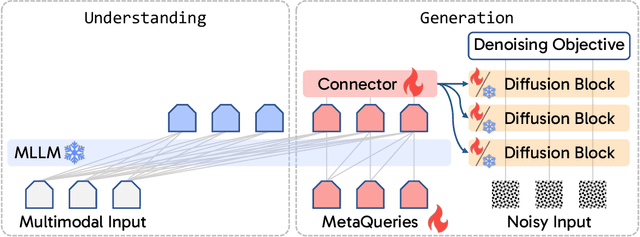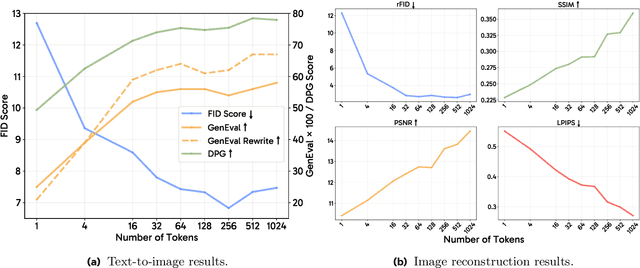Jialiang Wang
PhyGDPO: Physics-Aware Groupwise Direct Preference Optimization for Physically Consistent Text-to-Video Generation
Dec 31, 2025Abstract:Recent advances in text-to-video (T2V) generation have achieved good visual quality, yet synthesizing videos that faithfully follow physical laws remains an open challenge. Existing methods mainly based on graphics or prompt extension struggle to generalize beyond simple simulated environments or learn implicit physical reasoning. The scarcity of training data with rich physics interactions and phenomena is also a problem. In this paper, we first introduce a Physics-Augmented video data construction Pipeline, PhyAugPipe, that leverages a vision-language model (VLM) with chain-of-thought reasoning to collect a large-scale training dataset, PhyVidGen-135K. Then we formulate a principled Physics-aware Groupwise Direct Preference Optimization, PhyGDPO, framework that builds upon the groupwise Plackett-Luce probabilistic model to capture holistic preferences beyond pairwise comparisons. In PhyGDPO, we design a Physics-Guided Rewarding (PGR) scheme that embeds VLM-based physics rewards to steer optimization toward physical consistency. We also propose a LoRA-Switch Reference (LoRA-SR) scheme that eliminates memory-heavy reference duplication for efficient training. Experiments show that our method significantly outperforms state-of-the-art open-source methods on PhyGenBench and VideoPhy2. Please check our project page at https://caiyuanhao1998.github.io/project/PhyGDPO for more video results. Our code, models, and data will be released at https://github.com/caiyuanhao1998/Open-PhyGDPO
Sharpness-aware Second-order Latent Factor Model for High-dimensional and Incomplete Data
Dec 18, 2025Abstract:Second-order Latent Factor (SLF) model, a class of low-rank representation learning methods, has proven effective at extracting node-to-node interaction patterns from High-dimensional and Incomplete (HDI) data. However, its optimization is notoriously difficult due to its bilinear and non-convex nature. Sharpness-aware Minimization (SAM) has recently proposed to find flat local minima when minimizing non-convex objectives, thereby improving the generalization of representation-learning models. To address this challenge, we propose a Sharpness-aware SLF (SSLF) model. SSLF embodies two key ideas: (1) acquiring second-order information via Hessian-vector products; and (2) injecting a sharpness term into the curvature (Hessian) through the designed Hessian-vector products. Experiments on multiple industrial datasets demonstrate that the proposed model consistently outperforms state-of-the-art baselines.
Exploring MLLM-Diffusion Information Transfer with MetaCanvas
Dec 12, 2025Abstract:Multimodal learning has rapidly advanced visual understanding, largely via multimodal large language models (MLLMs) that use powerful LLMs as cognitive cores. In visual generation, however, these powerful core models are typically reduced to global text encoders for diffusion models, leaving most of their reasoning and planning ability unused. This creates a gap: current multimodal LLMs can parse complex layouts, attributes, and knowledge-intensive scenes, yet struggle to generate images or videos with equally precise and structured control. We propose MetaCanvas, a lightweight framework that lets MLLMs reason and plan directly in spatial and spatiotemporal latent spaces and interface tightly with diffusion generators. We empirically implement MetaCanvas on three different diffusion backbones and evaluate it across six tasks, including text-to-image generation, text/image-to-video generation, image/video editing, and in-context video generation, each requiring precise layouts, robust attribute binding, and reasoning-intensive control. MetaCanvas consistently outperforms global-conditioning baselines, suggesting that treating MLLMs as latent-space planners is a promising direction for narrowing the gap between multimodal understanding and generation.
Variation-Bounded Loss for Noise-Tolerant Learning
Nov 15, 2025Abstract:Mitigating the negative impact of noisy labels has been aperennial issue in supervised learning. Robust loss functions have emerged as a prevalent solution to this problem. In this work, we introduce the Variation Ratio as a novel property related to the robustness of loss functions, and propose a new family of robust loss functions, termed Variation-Bounded Loss (VBL), which is characterized by a bounded variation ratio. We provide theoretical analyses of the variation ratio, proving that a smaller variation ratio would lead to better robustness. Furthermore, we reveal that the variation ratio provides a feasible method to relax the symmetric condition and offers a more concise path to achieve the asymmetric condition. Based on the variation ratio, we reformulate several commonly used loss functions into a variation-bounded form for practical applications. Positive experiments on various datasets exhibit the effectiveness and flexibility of our approach.
Joint Asymmetric Loss for Learning with Noisy Labels
Jul 23, 2025Abstract:Learning with noisy labels is a crucial task for training accurate deep neural networks. To mitigate label noise, prior studies have proposed various robust loss functions, particularly symmetric losses. Nevertheless, symmetric losses usually suffer from the underfitting issue due to the overly strict constraint. To address this problem, the Active Passive Loss (APL) jointly optimizes an active and a passive loss to mutually enhance the overall fitting ability. Within APL, symmetric losses have been successfully extended, yielding advanced robust loss functions. Despite these advancements, emerging theoretical analyses indicate that asymmetric losses, a new class of robust loss functions, possess superior properties compared to symmetric losses. However, existing asymmetric losses are not compatible with advanced optimization frameworks such as APL, limiting their potential and applicability. Motivated by this theoretical gap and the prospect of asymmetric losses, we extend the asymmetric loss to the more complex passive loss scenario and propose the Asymetric Mean Square Error (AMSE), a novel asymmetric loss. We rigorously establish the necessary and sufficient condition under which AMSE satisfies the asymmetric condition. By substituting the traditional symmetric passive loss in APL with our proposed AMSE, we introduce a novel robust loss framework termed Joint Asymmetric Loss (JAL). Extensive experiments demonstrate the effectiveness of our method in mitigating label noise. Code available at: https://github.com/cswjl/joint-asymmetric-loss
DRSLF: Double Regularized Second-Order Low-Rank Representation for Web Service QoS Prediction
May 03, 2025

Abstract:Quality-of-Service (QoS) data plays a crucial role in cloud service selection. Since users cannot access all services, QoS can be represented by a high-dimensional and incomplete (HDI) matrix. Latent factor analysis (LFA) models have been proven effective as low-rank representation techniques for addressing this issue. However, most LFA models rely on first-order optimizers and use L2-norm regularization, which can lead to lower QoS prediction accuracy. To address this issue, this paper proposes a double regularized second-order latent factor (DRSLF) model with two key ideas: a) integrating L1-norm and L2-norm regularization terms to enhance the low-rank representation performance; b) incorporating second-order information by calculating the Hessian-vector product in each conjugate gradient step. Experimental results on two real-world response-time QoS datasets demonstrate that DRSLF has a higher low-rank representation capability than two baselines.
Token-Shuffle: Towards High-Resolution Image Generation with Autoregressive Models
Apr 24, 2025Abstract:Autoregressive (AR) models, long dominant in language generation, are increasingly applied to image synthesis but are often considered less competitive than Diffusion-based models. A primary limitation is the substantial number of image tokens required for AR models, which constrains both training and inference efficiency, as well as image resolution. To address this, we present Token-Shuffle, a novel yet simple method that reduces the number of image tokens in Transformer. Our key insight is the dimensional redundancy of visual vocabularies in Multimodal Large Language Models (MLLMs), where low-dimensional visual codes from visual encoder are directly mapped to high-dimensional language vocabularies. Leveraging this, we consider two key operations: token-shuffle, which merges spatially local tokens along channel dimension to decrease the input token number, and token-unshuffle, which untangles the inferred tokens after Transformer blocks to restore the spatial arrangement for output. Jointly training with textual prompts, our strategy requires no additional pretrained text-encoder and enables MLLMs to support extremely high-resolution image synthesis in a unified next-token prediction way while maintaining efficient training and inference. For the first time, we push the boundary of AR text-to-image generation to a resolution of 2048x2048 with gratifying generation performance. In GenAI-benchmark, our 2.7B model achieves 0.77 overall score on hard prompts, outperforming AR models LlamaGen by 0.18 and diffusion models LDM by 0.15. Exhaustive large-scale human evaluations also demonstrate our prominent image generation ability in terms of text-alignment, visual flaw, and visual appearance. We hope that Token-Shuffle can serve as a foundational design for efficient high-resolution image generation within MLLMs.
Transfer between Modalities with MetaQueries
Apr 08, 2025



Abstract:Unified multimodal models aim to integrate understanding (text output) and generation (pixel output), but aligning these different modalities within a single architecture often demands complex training recipes and careful data balancing. We introduce MetaQueries, a set of learnable queries that act as an efficient interface between autoregressive multimodal LLMs (MLLMs) and diffusion models. MetaQueries connects the MLLM's latents to the diffusion decoder, enabling knowledge-augmented image generation by leveraging the MLLM's deep understanding and reasoning capabilities. Our method simplifies training, requiring only paired image-caption data and standard diffusion objectives. Notably, this transfer is effective even when the MLLM backbone remains frozen, thereby preserving its state-of-the-art multimodal understanding capabilities while achieving strong generative performance. Additionally, our method is flexible and can be easily instruction-tuned for advanced applications such as image editing and subject-driven generation.
Learnings from Scaling Visual Tokenizers for Reconstruction and Generation
Jan 16, 2025



Abstract:Visual tokenization via auto-encoding empowers state-of-the-art image and video generative models by compressing pixels into a latent space. Although scaling Transformer-based generators has been central to recent advances, the tokenizer component itself is rarely scaled, leaving open questions about how auto-encoder design choices influence both its objective of reconstruction and downstream generative performance. Our work aims to conduct an exploration of scaling in auto-encoders to fill in this blank. To facilitate this exploration, we replace the typical convolutional backbone with an enhanced Vision Transformer architecture for Tokenization (ViTok). We train ViTok on large-scale image and video datasets far exceeding ImageNet-1K, removing data constraints on tokenizer scaling. We first study how scaling the auto-encoder bottleneck affects both reconstruction and generation -- and find that while it is highly correlated with reconstruction, its relationship with generation is more complex. We next explored the effect of separately scaling the auto-encoders' encoder and decoder on reconstruction and generation performance. Crucially, we find that scaling the encoder yields minimal gains for either reconstruction or generation, while scaling the decoder boosts reconstruction but the benefits for generation are mixed. Building on our exploration, we design ViTok as a lightweight auto-encoder that achieves competitive performance with state-of-the-art auto-encoders on ImageNet-1K and COCO reconstruction tasks (256p and 512p) while outperforming existing auto-encoders on 16-frame 128p video reconstruction for UCF-101, all with 2-5x fewer FLOPs. When integrated with Diffusion Transformers, ViTok demonstrates competitive performance on image generation for ImageNet-1K and sets new state-of-the-art benchmarks for class-conditional video generation on UCF-101.
DirectorLLM for Human-Centric Video Generation
Dec 19, 2024



Abstract:In this paper, we introduce DirectorLLM, a novel video generation model that employs a large language model (LLM) to orchestrate human poses within videos. As foundational text-to-video models rapidly evolve, the demand for high-quality human motion and interaction grows. To address this need and enhance the authenticity of human motions, we extend the LLM from a text generator to a video director and human motion simulator. Utilizing open-source resources from Llama 3, we train the DirectorLLM to generate detailed instructional signals, such as human poses, to guide video generation. This approach offloads the simulation of human motion from the video generator to the LLM, effectively creating informative outlines for human-centric scenes. These signals are used as conditions by the video renderer, facilitating more realistic and prompt-following video generation. As an independent LLM module, it can be applied to different video renderers, including UNet and DiT, with minimal effort. Experiments on automatic evaluation benchmarks and human evaluations show that our model outperforms existing ones in generating videos with higher human motion fidelity, improved prompt faithfulness, and enhanced rendered subject naturalness.
 Add to Chrome
Add to Chrome Add to Firefox
Add to Firefox Add to Edge
Add to Edge